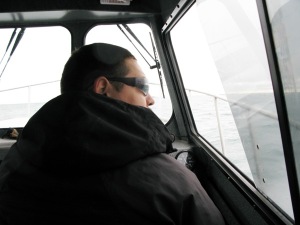This is the second post by Skidaway Institute professor Marc Frischer, chronicling his research trip to Barrow, Alaska, for his study of the effect of a warming climate on the coastal ecology there.
Just completing day 3 of the expedition. After staying-up half the night to get ready for an 8:00 am sampling trip, the weather delayed us. We were fogged in. But what can you do? That is the nature of fieldwork.
After waiting around until nearly noon, the fog had finally dissipated sufficiently so that our native whaling captain, Captain Quinik (pronounced something like “Cone – Nick”), gave the long-awaited ok.
We followed captain Quinik and his first mate to the launch ramp located several miles east of the research station and launched on the Chukchi Sea side of Point Barrow. For about an hour we motored our way around Point Barrow, into the Beaufort Sea, and to our sampling station about 3 miles north of the station. It was a choppy ride but the boat, a sturdy 27’ aluminum hulled boat with two brand new 175 four stroke Suzuki engines, handled it well.
Once on station we began our collections. Since there are three teams of us collecting different types of water samples and data, we had to carefully choreograph our activities. First on the agenda was to determine the basic characteristics of the water. Its depth, 12M (about 40 ft); its temperature, 6°C (around 43°F); its salinity, 31.4 o/o; and the oxygen content (fully saturated with the atmosphere).
We also measured light penetration which was the most important parameter for determining our sampling depth since we are conducting experimental incubation studies and need to match the light levels in the lab.
All this data told us that we had a very well mixed water column typical of the region for this time of year. Just what we were hoping for!
After these measurements were completed, the Yager team ( for Patricia Yager, UGA) began collecting water for their studies to characterize the carbon chemistry of the water and the activity and abundance of the bacteria and phytoplankton. After they were nearly finished, we deployed a special submersible pump to 4M, our optimal sampling depth, and the Bronk team (for Deborah Bronk, Virginia Institute for Marine Science) began collecting water and filling up what seems like hundreds of sample jars for their experiments.
The Bronk group is interested in understanding the effects of different nutrient additions on Arctic microbial populations. They are especially interested in humic materials, since those are expected to be released in high concentrations as the permafrost melts into the coastal Arctic ocean. Humics are the left over organic matter from plants that make the water in our neck of the woods tea colored.
As the Bronk team completed their sampling it was our turn. We collected 120 liters (a little more that 30 gallons) of water for our genetic studies that we are conducting to provide insight in how microbial communities may adapt to future changes. Once all the samples were safely on board and our gear stowed safely, we returned to the lab.
Luckily, since the water was relatively calm, we were able to head south and offload our samples onto the beach which we were then able to easily transport to our various laboratories.
After the sampling expedition, the rest of the day was a blur, with each of us rushing around trying to get everything done. But it was a pleasure since this is what we had been planning for so long. Victoria and I spent about six hours in a walk-in cold room set at ambient water temperature filtering all the water we collected. As I’m typing now (nearly midnight) the Yager group is still at it though the Bronk group has already called it quits for the day.
Tomorrow is a lab day and should present a lighter workload for all of us. I’m hoping I’ll be able to visit the whaling camp (think ice fishing camp) and soak it all in.
The native Iñupiat Eskimos, who make up over 60% of the 4,000+ residents, authentically practice their culture and seem to be eager to share it with interested visitors.






